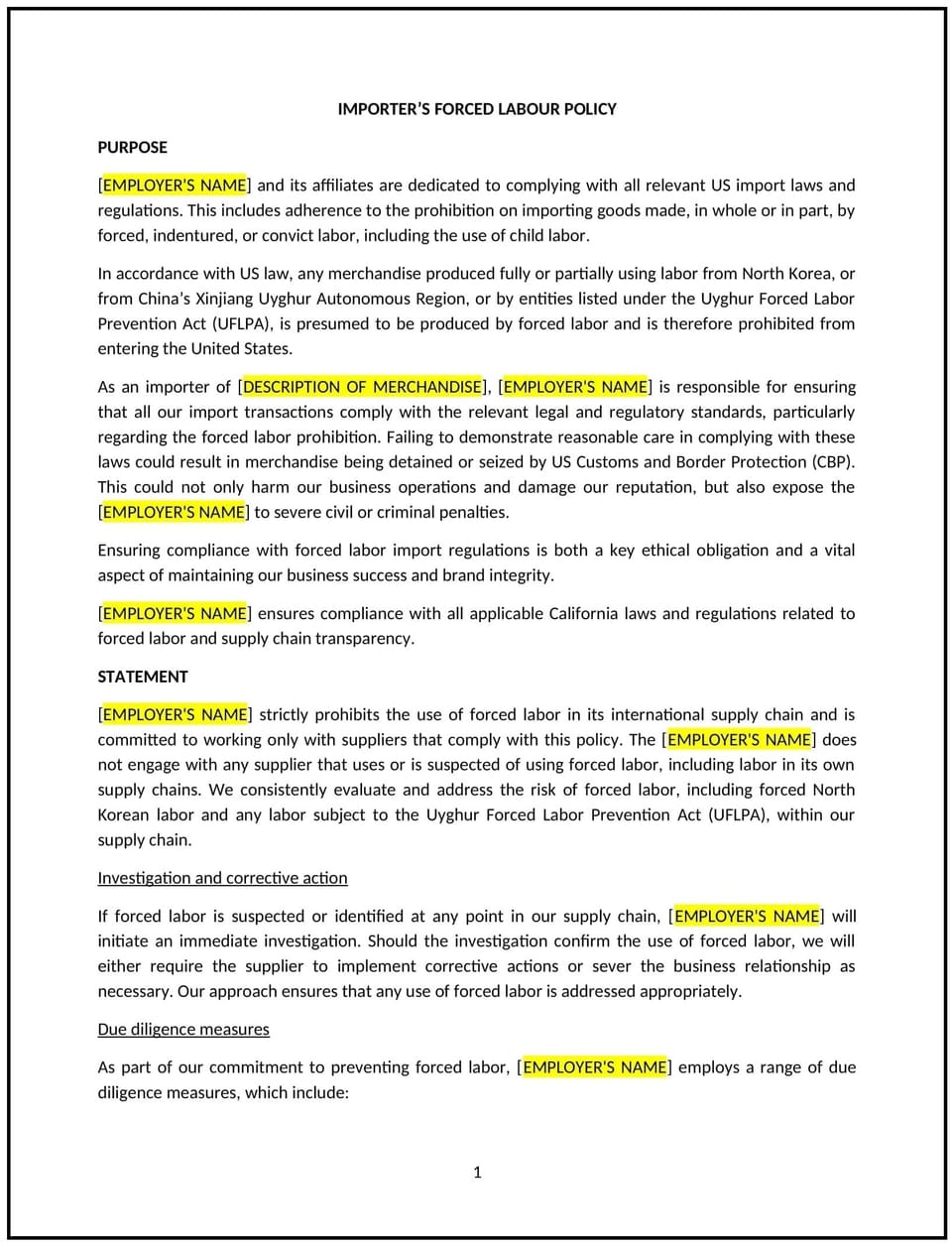Importer's forced labour policy (California): Free template

Importer’s forced labor policy (California)
In California, an importer’s forced labor policy provides businesses with guidelines to ensure imported goods are not produced using forced labor. This policy supports compliance with California laws, such as the California Transparency in Supply Chains Act, and federal laws prohibiting the importation of goods made with forced labor under the Tariff Act of 1930.
This policy outlines the business’s commitment to ethical sourcing, procedures for assessing supply chains, and steps for addressing non-compliance. By implementing this policy, California businesses can promote ethical practices, protect their reputation, and mitigate legal risks.
How to use this importer’s forced labor policy (California)
- Define scope: Specify the products, suppliers, and regions covered by the policy to ensure clarity and accountability in supply chain oversight.
- Conduct due diligence: Establish procedures for assessing suppliers, including audits, certifications, and supply chain mapping to identify risks of forced labor.
- Communicate expectations: Outline supplier requirements to comply with ethical labor standards and California laws, including providing transparency reports.
- Establish corrective action plans: Detail steps for addressing non-compliance, such as terminating contracts or implementing remediation efforts.
- Monitor and review: Regularly evaluate the supply chain to ensure ongoing compliance and identify emerging risks.
Benefits of using this importer’s forced labor policy (California)
This policy offers several advantages for California businesses:
- Supports compliance: Reflects California and federal laws prohibiting the use of forced labor in supply chains.
- Protects reputation: Demonstrates the business’s commitment to ethical sourcing and corporate social responsibility.
- Mitigates risks: Reduces exposure to legal, financial, and reputational risks associated with forced labor violations.
- Promotes transparency: Encourages openness in supply chain practices, fostering trust with stakeholders and customers.
- Enhances accountability: Provides clear guidelines for suppliers and internal teams to uphold ethical standards.
Tips for using this importer’s forced labor policy (California)
- Reflect California-specific laws: Address requirements under the California Transparency in Supply Chains Act, including mandatory disclosure obligations.
- Partner with trusted auditors: Use reputable third-party auditors to assess supplier compliance and verify labor practices.
- Train employees: Educate procurement teams on identifying risks of forced labor and implementing ethical sourcing practices.
- Engage suppliers: Collaborate with suppliers to improve labor standards and ensure compliance with the policy.
- Review regularly: Update the policy to reflect changes in California laws, federal regulations, or global supply chain dynamics.
Q: How does this policy benefit the business?
A: This policy supports compliance with California and federal laws, protects the business’s reputation, and demonstrates a commitment to ethical sourcing.
Q: What steps can the business take to ensure compliance with this policy?
A: The business can conduct supplier audits, require transparency reports, and implement corrective actions for non-compliance.
Q: How does this policy support compliance with California laws?
A: The policy reflects requirements under the California Transparency in Supply Chains Act and federal laws prohibiting forced labor.
Q: What actions should suppliers take to comply with this policy?
A: Suppliers should provide documentation of labor practices, undergo audits, and address any identified risks of forced labor in their operations.
Q: How can the business identify risks of forced labor in its supply chain?
A: The business can use tools such as supply chain mapping, risk assessments, and third-party audits to identify and mitigate potential risks.
This article contains general legal information and does not contain legal advice. Cobrief is not a law firm or a substitute for an attorney or law firm. The law is complex and changes often. For legal advice, please ask a lawyer.


